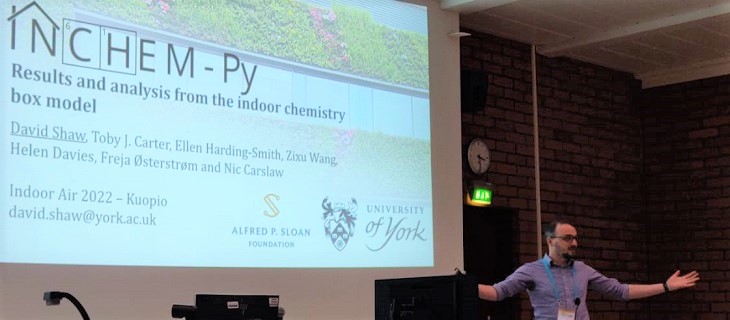
Alice Pengelly from the Clean Air Champions team spoke to Dr David Shaw from INGENIOUS to learn about his research into chemical reactions in family homes in Bradford.
David, a researcher at the University of York, is modelling reactions between chemicals found in our homes. His team is part of the INGENIOUS project, which is measuring air pollution in the homes of 300 families in Bradford to find ways we can all improve our indoor air quality.
Identifying chemicals harmful to our health
New chemicals are introduced into the air in our homes every time we do something like cook, clean, light a candle or use an air freshener. But there’s little known about how these react with other chemicals already present in the air, and what new chemicals are formed when they do so.
“You might have something that is generally harmless, but that thing could react with something else to produce something that is harmful,” David explains. “But if you’re not measuring for that harmful chemical in your experiment, then you won’t know it’s there.”
Some chemicals formed are known to be bad for our health. Limonene, for example, is a harmless chemical naturally found in lemon peel. It is commonly used in citrus-scented cleaning products.
“Limonene makes things smell like lemons and it’s lovely,” says David. “But then that will react with ozone and form formaldehyde – and you end up with quite a harmful, irritant chemical in your home.”
Predicting chemical reactions in our homes
David joined Prof Nicola Carslaw’s research group at the University of York three and a half years ago, with the aim of taking their model of indoor air chemistry and making it better.
“I was brought on board to turn it into an open access piece of software, that could then be used by other researchers to look at gas phase chemistry reactions that occur when we do things indoors.”
The model is designed so that researchers can measure the amount of one chemical in the air and put this into the model.The model then uses known chemical reactions and predicts amounts of new chemicals produced.
“They can’t measure every chemical species that is out there, but we have six and a half thousand chemical species in the model,” David explains. “Using these measurements of a few species, the model will tell you what chemical reactions are happening, how fast they are happening and what other chemicals are being produced when they’re reacting.”
The INGENIOUS project, which, in collaboration with the long-running Born in Bradford research project, is measuring the air pollution inside 300 families’ homes in Bradford.They will look at what these families do, the chemicals produced and potential effects on their health.
“The focus of my part of that is to take individual events, and then try and extract as much information from that as possible,” David explains.
At the end of the research, they will give the participant the results and tips on how they can improve the air quality in their homes.
Transferring skills from nuclear fusion
David started his career with a BSc in Physics with Astrophysics. He did a master’s and a subsequent PhD studying nuclear fusion, but then decided he wanted to switch to something different. This is how he came to study indoor air pollution with INGENIOUS.
“I’d been doing computer modelling for ages, and there’s not a lot of difference between modelling a fusion reactor and modelling indoor air,” David explains. “So, I took transferrable skills of modelling and just applied them somewhere else.”
It turned out to be a good move. He says that he really enjoys his current role. Most of all he really likes working with his research team.
“What I enjoy about my job is working with the people I work with,” he says. “I enjoy the fact that I’m doing something that is for the public good. I enjoy that we’re working towards a better future, and we’re at the forefront of the research and communicating that research. But what I enjoy most is working with the people that I work with.”